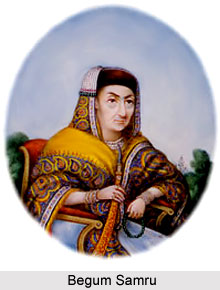 Begum Samru was a ruler of Sardhana, a principality near Meerut. Her full name was Begum Joanna Nobilis Sombre who was a Nautch girl in 18th Century India. She is also said to have played a stellar role in the political power struggle in 18th and 19th century India. She also served as the head of a professionally trained mercenary army that included both Europeans and Indian Army. She got this mercenary army from her European mercenary husband, Walter Reinhardt Sombre. Begum Samru was the only Catholic Ruler in India.
Begum Samru was a ruler of Sardhana, a principality near Meerut. Her full name was Begum Joanna Nobilis Sombre who was a Nautch girl in 18th Century India. She is also said to have played a stellar role in the political power struggle in 18th and 19th century India. She also served as the head of a professionally trained mercenary army that included both Europeans and Indian Army. She got this mercenary army from her European mercenary husband, Walter Reinhardt Sombre. Begum Samru was the only Catholic Ruler in India.
Life of Begum Samru
Begam Samru was of Kashmiri descent and was known for her outstanding leadership abilities. A fair complexioned lady she had led her army several times. She had married a mercenary soldier Walter Reinhardt Sombre of Luxembourg as a teenager. Her husband was then operating in India. Walter Reinhardt Sombre once visited a red light area where he saw the 14 year old Farzana and fell in love. Later he married her. Sombre later moved from Lucknow to Rohilkhand and then to Agra, Deeg and Bharatpur and back to the Doab. During these times, Farzana stayed with him and helped him in his work. Some of the European officers who lived with her husband also courted her. Among them were Le Vassoult, a Frenchman, and George Thomas, an Irishman. It is said that as the Begum favoured the Frenchman in 1793 she has married him. The couple thought of eloping secretly by night with Le Vassoult on horseback and the Begum in a palanquin. However, the Begum was misinformed that Le Vassoult had been shot hence she too stabbed herself but she survived. Her lover, however, died of a wound to the head.
Begum Samru throughout her life maintained a good relation with a close friend of hers, Begum Umdaa. The later belonged to the other Jagirdar Family of Sardhana. With time they both became very close friends and remained so until their death. When Begum Umdaa got married Samru took out time from her busy schedule to go and meet her friend Meerut. After the death of her husband Walter Reinhardt, she succeeded to his Principality yielding about 90,000 per annum. Even with the beginning of British Rule in 1803 in North India, she managed to retain her possessions as an independent ruler. She was well known for her commendable internal management of her estate. With time she greatly flourished as a ruler and gained name and power. She could establish herself as a powerful ruler of North India, ruling a large area from Sardhana, Uttar Pradesh. Her support and ruling skills were even acknowledged by the Mughal Emperor Shah Alam II. The British East India Company regarded as a threat to its territorial ambitions in undivided India. At the age of about forty, on the 7th of May, 1781, Begum Samru was baptized Joanna Nobilis, by a Roman Catholic priest.
Palace at Sardhana and Chandni Chowk
A palace was built by Begam Samru in Sardhana near Meerut. It was a great of much activity during the reign of Mughal Emperor, Akbar. Shah Alam, the predecessor and father of Akbar Shah, regarded Begum Samru as his daughter as she had saved Delhi from an invasion. She had come to rescue with a force of 30,000 Sikhs under Baghel Singh in 1783. The palace located in Chandni Chowk was gifted by Akbar Shah to the Begum. The massive building is now owned by the State Bank of India (SBI), Chandanai Chowk Branch.
In January 1837 she died at Sardhana, the capital of her Principality at the age of 85. Before her death she handed over her huge property to David Ochterlony Dyce Sombre, who descended from Walter Reinhardt Sombre, from his first wife.



















